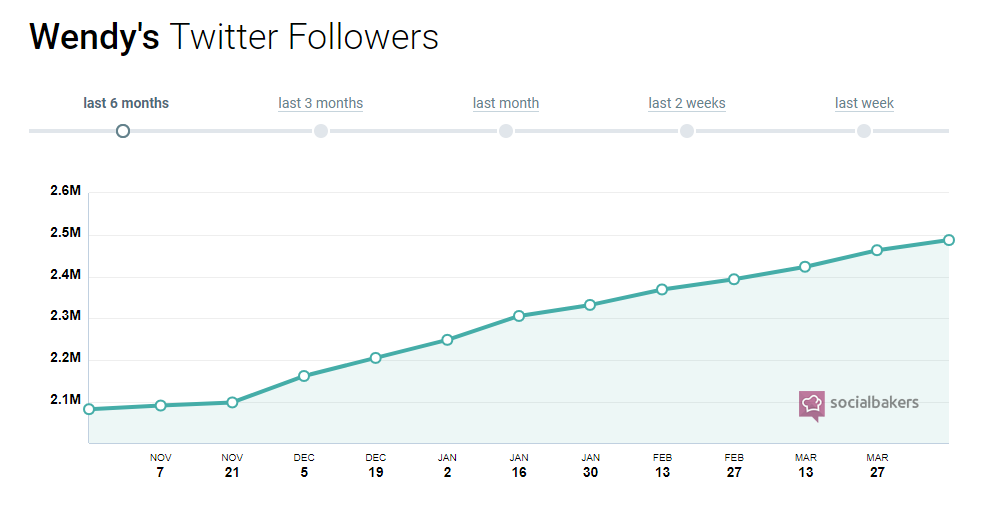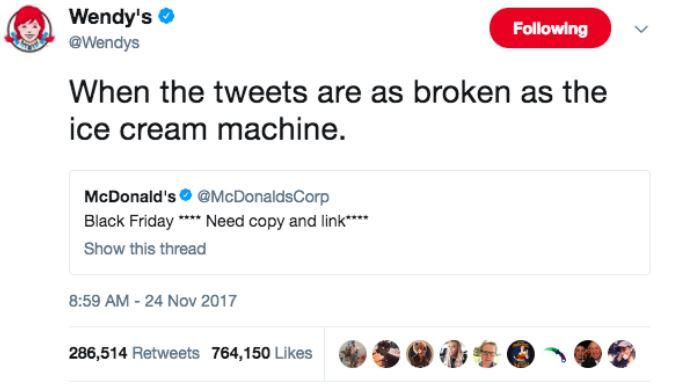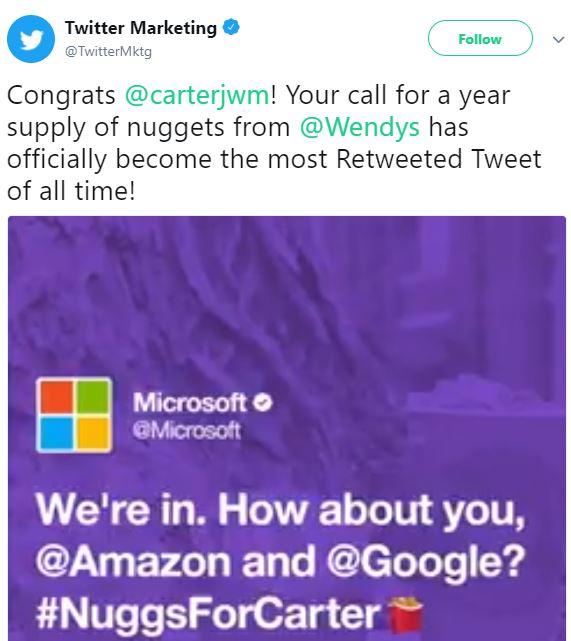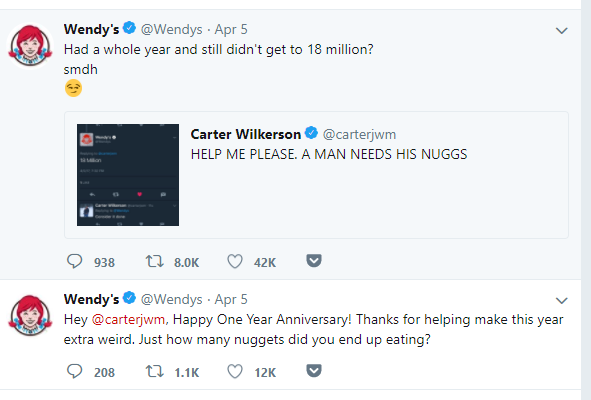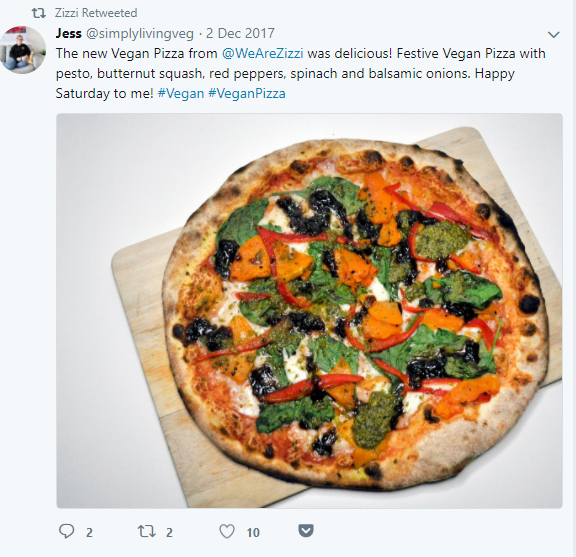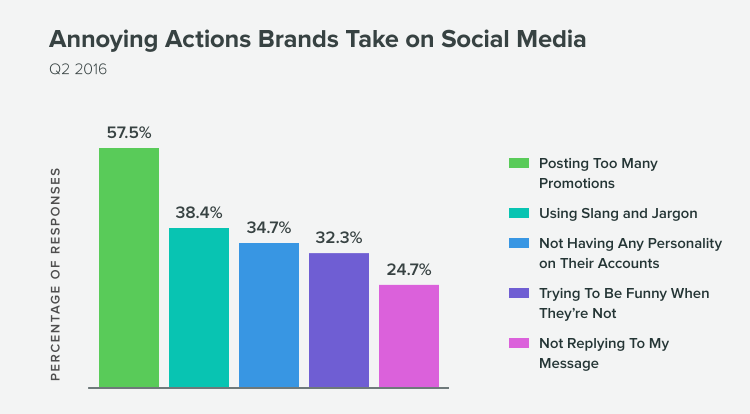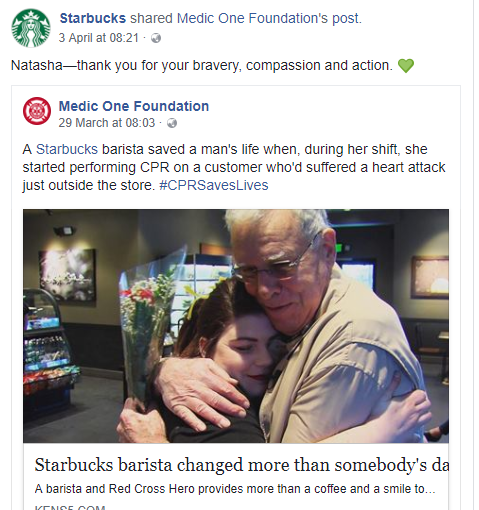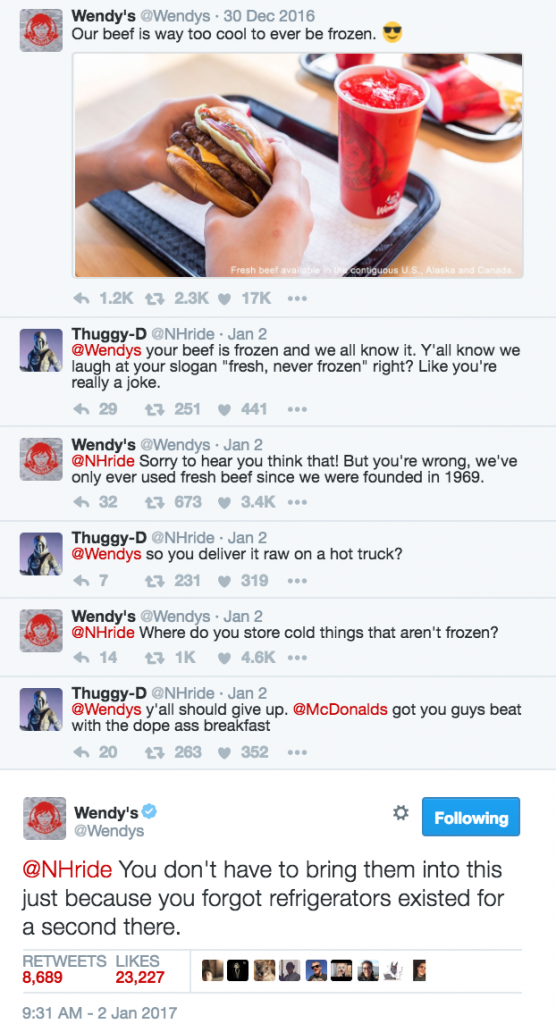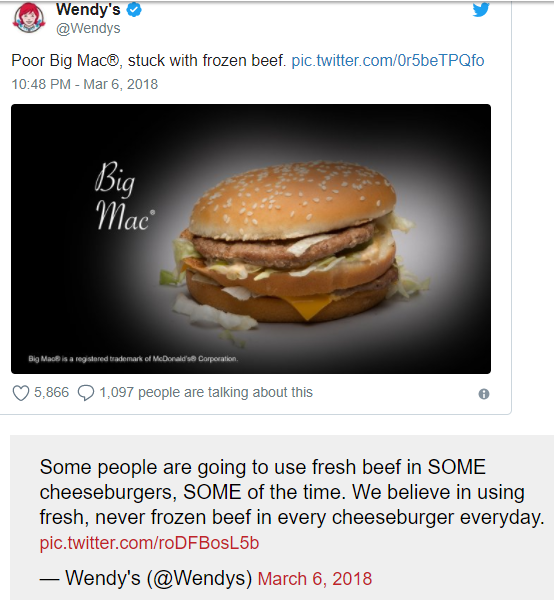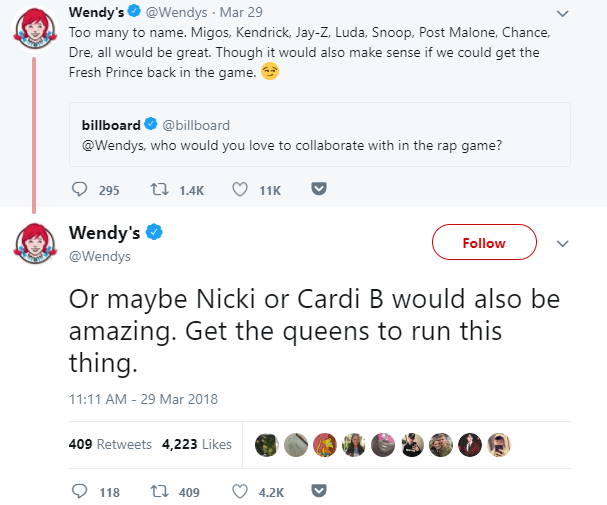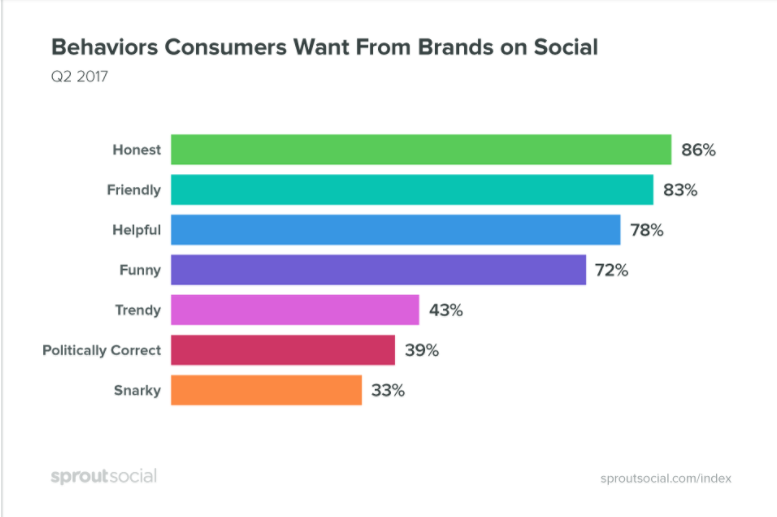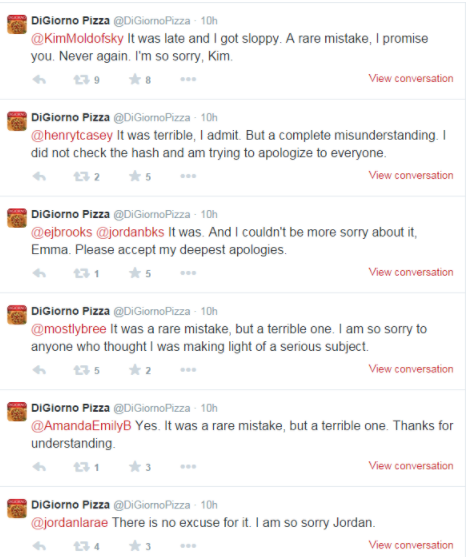If awards were handed out for the king and queen of social media last year, there’s no doubt that Wendy’s would take the crown. The fast-food chain stepped-up its social media game in 2017 by exchanging banter with followers and ‘trolling’ its competitors.
Anyone taking a look at Wendy’s Twitter might be mistaken for thinking that they have accidentally landed on the page of the chat show host who’s also the fast food restaurant’s namesake. That’s because the sassy language, quick wit, and references to pop culture wouldn’t be out of place on The Wendy Williams Show.
Wendy’s engagement levels have increased due to its willingness to fire off smart and witty answers to followers’ questions. Beyond engagement levels, Wendy’s also posted the following preliminary results for 2017:
Net income was $159.3 million in the fourth quarter of 2017 compared to net income of $28.9 million in the fourth quarter of 2016.
Net income was $194.0 million in 2017 compared to net income of $129.6 million in 2016.
Wendy’s experienced a 49.7% growth in profit from $129.6 million to $194 million for the year.
Additionally, for the first time ever, Wendy’s sales exceeded the $10 billion global sales target for 2017.
Sales aren’t the only aspect of Wendy’s experiencing growth. Wendy’s Twitter following has increased from 2.1 million to over 2.4 million in six months.
The chart below, courtesy of socialbakers.com, shows how Wendy’s following has been growing consistently.
Twitter followers can be considered a vanity metric if no one is interacting. Engagement is where Wendy’s shines as their posts usually get over 10,000 shares and more than 30,000 likes.
So, how did Wendy’s emerge as the restaurant that dominated social media in 2017 and, more importantly, how can your restaurant follow suit?
We’ll take a look at the main ingredients of Wendy’s winning social media strategy and also show you there’s no ‘secret sauce.’ Any restaurant can apply the same techniques to boost fans and sales.
Here are five tactics Wendy’s uses to keep its loyal fans engaged and keep coming back for more:
- It’s not all about customer service
- The power of storytelling
- Keep a consistent tone of voice
- Be prepared for damage control
- Hire the right people
1. It’s not all about customer service
Wendy’s user responsiveness stepped up a gear on April 5, 2017, when Carter Wilkerson tweeted asking “how many retweets for a year of free chicken nuggets?”
Wendy wasted no time in responding and set a challenge that 18 million tweets would secure a year’s worth of free chicken nuggets.
The #NuggsForCarter was born, went viral and became the most retweeted Tweet of all time, knocking Ellen DeGeneres’ famous Oscar selfie tweet off the top spot. #NuggsForCarter was retweeted 3,432,218 times and gained support from industry heavyweights, like Apple music and Microsoft. Ellen DeGeneres even mentioned the nuggets ‘campaign’ on her show.
Although Carter fell short of the 18 million retweet target, Wendy’s still awarded him a year of chicken nuggets for the excellent effort.
In the world of social media where things get forgotten in an instant, the nugget challenge still lives on, with Wendy’s mentioning the nuggets challenge a year later and still enjoying a high level of engagement.
User responsiveness takeaways for your restaurant
Social media is a great way to address customer service issues. It’s not unusual for customers who have had a negative experience at your restaurant to tweet about it.
If your social media pages are only filled with promotional dishes, any customer complaints will stick out like a sore thumb.
Take every opportunity to respond to customers’ comments and questions, especially when they’re complimentary.
The example below is somewhat of a wasted opportunity by the UK-based restaurant, Zizzi.
A retweet was good, but imagine how great this follower would have felt if they received a personalized response to their complementary tweet.
Where possible, personally responding to followers makes them feel like your restaurant appreciates their custom and wants to relate to them as people.
Wendy’s nailed the art of conversing with its followers by responding to queries that often have nothing to do with customer service.
Research by Sprout Social found that the most annoying action taken by brands was posting too many promotional posts.
Learn from Wendy’s approach and break-up the “hey, look how great our food is!” posts with those that facilitate human interaction.
Wendy’s may not have been exposed to an extra three million people, including national press if it hadn’t responded to Carter’s question about free nuggets. Imagine what meaningful interaction with your followers could do for your restaurant.
Along with meaningful interactions, imagine what an effective and efficient employee scheduling platform like Deputy can do for your restaurant. Imagine your managers spending their time fixing your restaurant and making you more money instead of spending hours each week creating employee schedules. Imagine your employees receiving their schedules right away instead of having to call or text their managers each time, along with that, imagine if your team was able to swap shifts with one another without you having to function as a middleman. Well imagine no more! Click on the button below to start your free trial of Deputy today to see it in action for yourself.

2. The power of storytelling
Wendy’s #PretzelLoveStories was rolled-out to introduce its Pretzel Pub Chicken sandwich. The campaign involved actors reading out customers’ tweets about the new sandwich in a silly, soap opera style.
These stories were produced in 2013 and show the power of storytelling, especially when humor is involved. The first installment of the story collected thousands of comments, views, and shares.
Wendy’s YouTube channel also shares stories about different aspects of its business, like how it sources products and also how its competitors use frozen beef. The frozen beef story has received over five million views so far.
Storytelling takeaways for your restaurant
To use storytelling effectively in your social media marketing, think about what makes your restaurant unique.
Some of Wendy’s stories are based on the fact that they use fresh beef while their competitors opt for frozen.
Do you have an interesting story to tell about your restaurant’s history or your staff?
You could also take inspiration from IHOP and remember to include your customers in your storytelling. IHOP’s VP of Marketing, Kirk Thompson stated:
“I think one of the most powerful things about the IHOP brand is that there is an unlimited number of stories that are told by our guests, whether they are children or all the way up to seniors and everywhere in between.”
Your storytelling can also center around local events. Small restaurants that don’t have the budget to shoot videos using famous actors, like Wendy’s, can tell the story of a local band or fundraising effort, like in the example below.
The great thing about storytelling is that stories happen every day. The fact that a restaurant has customers means that there will always be stories to tell. For example, Starbucks shared the story of how one of its barista’s saved someone’s life.
The following storytelling tips will help your restaurant to mix an idea with emotions to encourage followers to form a stronger connection to your restaurant:
- Use multimedia to tell your stories.
- Disclose something personal about your restaurant.
- Show real customers and staff to build authenticity.
- Encourage your users to tell and share their stories.
3. Keep a consistent tone of voice
A key part of Wendy’s social media success is identifying their target market and communicating in a tone of voice to reach this audience. Wendy’s describes their voice as a “challenger with charm” and “one of their main objectives was to attract millennials.” Wendy’s tone of voice translates to posts such as ‘roasting’ people who make derogatory comments. Here’s one of the most famous roasts below:
Wendy’s has also been ‘beefing’ with McDonald’s over using frozen beef. Here’s one of the multiple tweets that Wendy’s sent out after McDonald’s revealed that it would be using fresh beef in some of its burgers:
To continue to appeal to millennials, Wendy’s regularly uses pop culture references, like the one below. These references give Wendy’s credibility as they appear to be authentically involved in the culture of millennials:
Wendy’s has even released a mixtape called ‘We beefin?’, and the single ‘Rest in Grease’ reached number one on Spotify’s Global Viral 50.
Scrolling through Wendy’s Twitter feed, you realize that their brand voice isn’t a one-off. Their style of communicating with their audience is consistent and on-brand every time.
Tone of voice takeaways for your restaurant
The key to creating and maintaining a tone of voice that will resonate with your audience is to gain a deep understanding of your target market. Not every restaurant will get away with adopting a similar tone to Wendy’s. For example, eateries whose main customers are people aged 50 and over are unlikely to appreciate Wendy’s sassy tone.
When considering your tone of voice, keep in mind that customers value brands that display characteristics, like honesty and friendliness. Sprout Social has published the results of research into the traits that consumers want to see in brands:
Here are some tips to help you develop a consistent tone of voice for your restaurant that will resonate with your customers and grow your business:
Decide how you want your customers to view your restaurant. Do you want to be known for traditional values or for a more modern attitude?
Plan for different scenarios that can occur on social media and develop a sample response in your brand voice.
Be consistent with your brand voice across all social media platforms and in all situations to avoid confusing followers.
Your brand voice should make your followers feel like they have a relationship with your restaurant and, in turn, they are more likely to recommend you to their friends.
4. Be prepared for damage control
As much as Wendy’s has enjoyed success with its social media strategy, things don’t always go right. Wendy’s experienced a backlash in relation to a tweet of a Wendy’s version of an image of a character called Pepe the Frog. It emerged that Pepe the Frog was used by a white supremacist group and was labeled as a hate symbol by the Anti-Defamation League in September 2016.
Wendy’s was accused of taking it’s roasting too far and many denounced its controversial approach. When Wendy’s realized its error, the post was quickly deleted and they issued an apology explaining that they were unaware of the significance of the image.
This incident doesn’t appear to have caused any permanent damage to Wendy’s reputation or brand as it continues to use the occasional roasts to keep its audience engaged.
Damage control takeaways for your restaurant
Wendy’s isn’t the only restaurant that has caused grave offense on social media. DiGiorno pizza restaurant mistakenly used a hashtag about domestic violence to promote their pizza. The backlash was understandably swift and sharp.
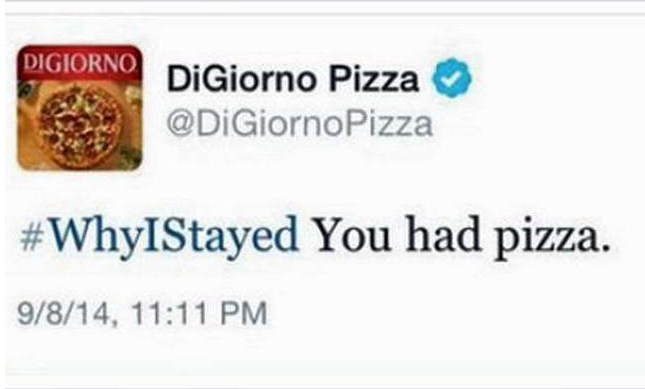
The following tips will help you to get a handle on a social media crisis:
Own up to your mistake – Once you have realized that your post has offended someone or a community, admit your mistake straight away and take full responsibility.
Don’t be defensive – If you have genuinely offended people, you should expect comments that come from a place of anger, hurt and disappointment. Resist the temptation to jump in to justify your actions.
Issue a formal apology – Where the damage has been caused on a large scale, your restaurant should issue the apology on all of your social media channels. Wendy’s apology advised that their community manager was unaware of the Pepe the Frog associations.
Re-examine your restaurant’s policies – Review and update your social media policies and train your staff in relation to safeguarding your reputation online.
Keep the conversation going – Acknowledge your followers’ feelings by speaking with them to reassure them that this was a one-off and you will be implementing measures to prevent these types of incidents happening again. DiGiorno pizza took the step of personally apologizing to everyone who complained.
Both Wendy’s and DiGiorno appeared to recover from their social media mishaps and your restaurant can, too. The flowchart below provides a process to follow when dealing with positive and negative social media content:
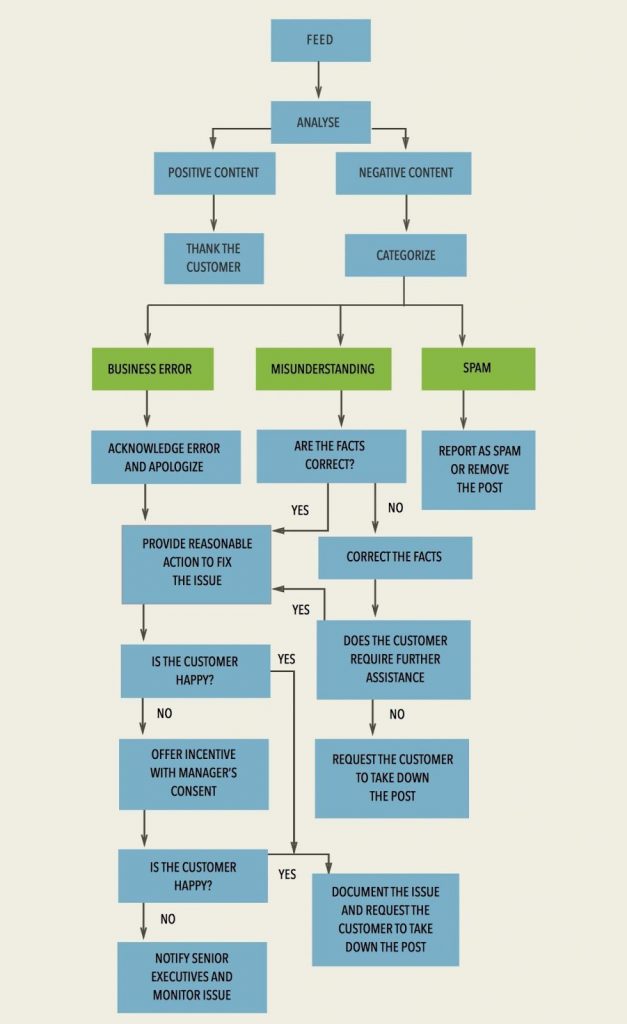
5. Hire the right people
Wendy’s social media team represent the personality of the brand at every point. Wendy’s team are familiar with its voice and target audience and provide consistency across all media channels.
The social media manager, Amy Brown, is credited as the mastermind behind Wendy’s social media success. Brown stated that:
“I think both as a brand and a human being trying to use Twitter, authenticity goes a long way. And, of course, being funny doesn’t hurt.”
Social media team hiring takeaways for your restaurant
Before you hire a social media manager for your restaurant, you need to have an idea about your strategy, including your voice. Don’t worry if you don’t have all the details, but knowing how you want your restaurant to be portrayed will help you to hire the right people. For example, Amy Brown was hired for Wendy’s after the VP of Advertising followed and trolled her on Twitter.
Hire a social media team that will stick to your strategy as well as take calculated risks. Wendy’s team said that:
“Success happened before anyone had a chance to be scared…and then we just kept going through mistakes.”
Work with your team to identify posts that need prior authorization and give them the autonomy to interact with users to represent your restaurant in the best light.
Lastly, ensure that your social media strategy and messaging is clear so that, if one of your team leaves, your followers will get a consistent voice.
Amy Brown has now left Wendy’s but, despite her departure, they’re still serving up sass, roasts, and humor.
Wendy’s has used social media in an authentic way to grow its customer base and profits. Your restaurant should follow suit and focus on a social media strategy to turn your fans into diners.
Hungry for more tips on managing your restaurant? Subscribe to The Deputy blog for more insights like this and make sure to click on the button below to begin your free trial to see first hand how Deputy can benefit your business.

